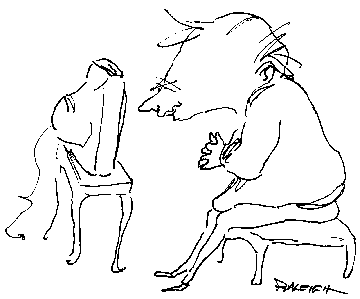By
HENRY P. RALEIGH
ART
TIMES January/February 2007
|
There's no doubt that a steady diet of the oldies has a beneficial effect on a curmudgeon. He may be unable to recall the cast of any recent film he's seen and confuses Al Pacino with Robert De Niro, yet he experiences a good deal of satisfaction in recognizing by sight and name long ago bit players as Allen Jenkins, Nat Pendelton, Frank McHugh, Ned Sparks— gleefully shouting out their identities to anyone unlucky enough to pass by. And how many can do that anymore?
Now, as a matter of fact, and if you want to be hard-nosed about it, the 1930's weren't the best of times by a long shot. Still, you wouldn't know that from the films of the period and maybe that's why curmudgeons of a certain age remember that time as the good old days, just as they remember them in deep focus and entirely in black and white. It is difficult to believe, but these curmudgeons were little tikes back then and they went to a lot of movies — three to six a week. Hollywood turned out over 500 films a year, 65% of the population paid theater admissions annually, theaters showed them two or three times at a clip, all for ten or fifteen cents. If parents were too caught up by the Depression to teach the tykes the ways of the world and the birds and the bees, well sir, the movies would serve as well — and they did. From these the young curmudgeons could learn the preferred style of smoking — cigarette hanging from corner of mouth, two-finger cupped in palm Bogart fashion, threee-finger straight out foreign look and women comb hair slicked back and shiny, girls bobbed and permed. Men wore suits on all occasions topped by a neat snap-brim fedora and were never at a loss for a ready wisecrack. Best of all, opportunity always lay around the corner. Didn't Longfellow Deeds in the 1936 “Mr Deeds Goes to Town” come into twenty million dollars just like that? Wouldn't a millionaire inevitably appear to back those talented kids in a smash stage production as in the “Gold Digger” and “Big Broadcast” films of ’32 to ’38? How about Jean Arthur's working girl in the ’37 “Easy Street”, walking along minding her business when a fur coat lands on her head, thrown out by millionaire Edward Arnold who has a rich son who immediately falls in love with her. The 30's had a bountiful supply of rich sons. Just a year later Jean Arthur lands another one in “You Can't Take it With You”. So does Anna Neagle in “Irene”. You could hardly take a step in the 30's without stumbling over a wealthy benefactor. “My Man Godfry” in ’36 is loaded with millionaires who, having little else to do, turn a city dump into a profitable night club with accommodations to house fifty of the less fortunate.
For instructions in how to display your riches, sophisticated manner and how to mix a proper martini could be learned from the “Thin Man” films; Myrna Loy is the millionaire here. For Art Deco elegance the Astaire/Rogers films couldn't be beat nor could the carefree, hi-style life shown in “The Awful Truth”, “Topper”, and “bringing Up Baby”. For today's ageing curmudgeons this was the world. The Hays Office kept that film world morally pure, saw to it that romance would not be corrupted by sex, the spoken word cleaned of vulgarity. Crime films may have been the closest to real life but here too, censorship put brakes on violence and brutality, larded them heavily with ‘crime absolutely doesn't pay’ lessons. Still they were good for teaching you how to talk tough without cussing.
This idealized reality served as a hypnotic influence on young minds. Whether comic, romantic, gangster or adventure, the 30's films were astonishing alike, all the studios observed the same formulas of plot, editing pace, shooting sequence, the same familiar faces appeared over and over — Hollywood film reality was consistent and pervasive. B films just like the A's only a bit faster and more cheaply produced, occasionally with newer actors being tried out for star quality. When curmudgeons look back with pleasure on the good old days it's most likely they see them through the lens of the 1930's camera. So if some grey-beards are given to boring recollections of how things used to be, keep in mind they're of the first generation to be largely shaped by the movies — and maybe the last. By the 1970's only ten percent of the population attend films and that number is shrinking. Television and the internet are busily shaping the next bunch of curmudgeons. And heaven knows what they can look back to as the ‘good old days’.

